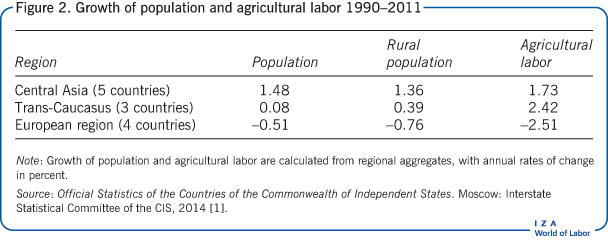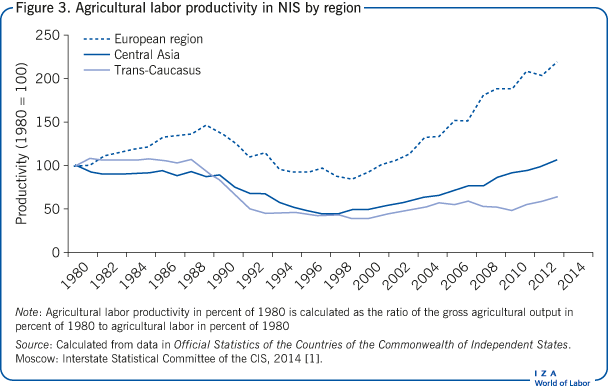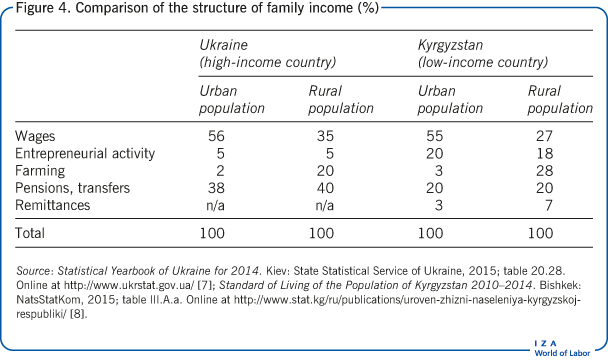Elevator pitch
The increase in agricultural employment in Central Asia and Trans-Caucasus over the last two decades has had a detrimental effect on agricultural labor productivity and rural family incomes. Transition countries in the former USSR cannot, however, encourage exits from agriculture (as, for instance, in east Germany or the Czech Republic) due to the risk of mass rural–urban migration, which may exacerbate growing urban unemployment. With large rural populations, state budgets would be unable to deal with a new wave of unemployed in urban areas.
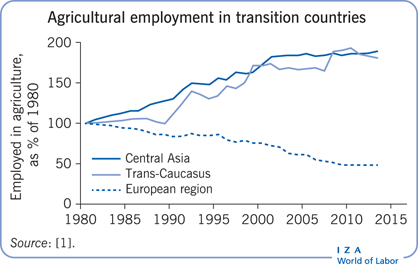
Key findings
Pros
Self-employment in agriculture guarantees low levels of rural unemployment.
Subsistence agriculture provides a safety net for the rural population.
Surplus production can be sold for cash to consumers, increasing family income, diversifying income sources, and reducing vulnerability to risk.
Rural family incomes can be increased by adopting productivity-enhancing technologies.
The rural population in the former USSR is characterized by high levels of literacy and adequate formal educational attainments.
Cons
Hidden unemployment in rural areas is rampant, allegedly reducing agricultural labor productivity.
Rural family incomes are substantially lower than urban incomes.
Sale of farm products requires transportation and marketing infrastructure, including covered regional markets with adequate facilities.
Technology adoption requires properly organized agricultural extension services.
Quality of training and existing skills are not always adequate to meet technological requirements.
Author's main message
The growth of agricultural labor in Trans-Caucasus and Central Asia has a potentially negative effect on productivity and creates hidden unemployment. Yet the transition countries cannot encourage exits from agriculture as this may result in an excessive burden of unemployment and other welfare benefits on the national budget. Alternative policies should be designed to encourage non-agricultural employment and entrepreneurship in rural areas, through targeted training and the removal of administrative constraints on rural businesses. Policy to support infrastructure development will stimulate farm sales as a mode of rural entrepreneurship, thus contributing to improved rural incomes.
Motivation
After 25 years of transition, most New Independent States (NIS) still have high levels of agricultural employment but low agricultural productivity. Nevertheless, agriculture fills an important role as a safety net for the large rural population, for whom the small labor-intensive family farms are a source of food and income. Encouraging diversification away from agriculture may potentially increase the chronically low agricultural productivity in these countries, though such policy would also most probably result in rural-to-urban migration and cause an increase in unemployment overall. In addition, it would exacerbate the depopulation of rural areas, which is an undesirable trend that has already been observed in Russia and Ukraine. These phenomena will put additional pressure on state budgets, which is something that transition countries can currently ill-afford.
The transition countries need alternative rural policies—policies that strive to increase agricultural productivity and family incomes while keeping the population firmly anchored in the rural areas (at least in the medium term).
Discussion of pros and cons
Agricultural employment and agrarian reform
Most NIS are highly agrarian, especially compared with Western Europe and North America. Agricultural employment is one of the dimensions by which the rural or agrarian character of a country can be assessed (other dimensions include the share of agriculture in GDP and the share of the rural population—see, for example, [2]). Figure 1 compares the share of agricultural employment (in % of total employment) across three large groupings of countries: the NIS, the countries of Central Europe and the Baltics (CEB) (where transition began at about the same time as in the NIS), and the EU. The share of agricultural employment generally decreases over time for each group of countries—a secular trend associated with general economic development. Yet the NIS in aggregate consistently attain the highest levels of agricultural employment—higher even than in other post-socialist countries in CEB. Averaged over nearly 20 years (1996–2014), the share of agricultural employment for the NIS is 28%, compared with 16% for CEB and 6% for the EU. While there is a well-known inverse relationship between a country’s agrarian character measures and per capita income [3], the NIS emerge as more agrarian, even relative to countries with comparable per capita income [4].
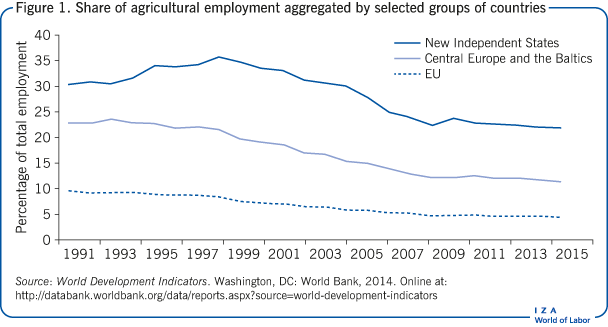
The Illustration shows that agricultural employment in the European region is steadily (and fairly slowly) decreasing over time. This trend is not related to transition: it goes back to 1980 (and earlier) and reflects the long-term exit of labor from agriculture in the developed and high-income countries of the European region. On the other hand, agricultural employment in Central Asia is increasing fairly rapidly. Again, this trend is observed since 1980 (and earlier) and is not related to transition. Instead, it appears to be driven by the high population growth rates and the increasing rural populations in these countries [1]. Finally, in the three Trans-Caucasus countries, agricultural labor began to grow only in 1990, apparently in response to the rapid transformation of the farm structure from large collectives to small family farms during the transition. Indeed, empirical evidence shows that everywhere in the world family farms act as “labor sink,” attracting many more workers per unit of land than large corporate farms [5].
Agricultural employment and rural population
Agriculture is a rural occupation, with rural populations providing the source of agricultural labor. In theoretical models, the growth or decline of agricultural labor is linked to rural population growth and the growth of non-agricultural sectors of the economy. Accordingly, rural population growth increases the supply of labor, which inevitably requires the creation of new jobs in agriculture. Growth in non-agricultural sectors of the economy, on the other hand, creates alternative employment opportunities, encouraging the migration of labor out of agriculture (a “pull” factor). For NIS, however, statistical data are insufficient to rigorously determine how agricultural employment is affected by GDP growth, reflecting general expansion in both agricultural and non-agricultural sectors. While the share of agricultural employment with respect to total employment in the economy is increasing, the share of agriculture in GDP is decreasing in all NIS [2], [6]. However, although convenient, this percentage statistic does not explain the variation in agricultural labor.
Instead, population growth statistics explain better the observed employment trends. Aggregating the 12 NIS into three groups (Trans-Caucasus, Central Asia, and the European region), a strong and positive relationship between the variation of agricultural labor and rural population from 1980 to 2011 (based on latest available data) can be observed. Accordingly, agricultural employment appears to have increased in those groups of countries where rural population is increasing (Trans-Caucasus and Central Asia), whereas in the European region both agricultural employment and rural population have declined over time. This supports the hypothesis that population pressures are a driver for agricultural employment [2], [6].
The decline of the aggregate rural population in the European region is a reflection of a declining rural population in each of the four countries (Belarus, Moldova, Russia, and Ukraine), where total population is also declining. The rapid growth of the aggregate rural population in Central Asia is similarly a reflection of a growing population in all five countries, although the rural population in Kazakhstan is increasing much more slowly than in the other four countries (an increase of 10% between 1980 and 2011, compared with 72% in the five Central Asia countries in aggregate). Kazakhstan is an exception in Central Asia, probably because of its relatively high per capita income, which makes its profile closer to Russia and Ukraine than to the rest of Central Asia.
In Trans-Caucasus, the rural population has increased quite rapidly in Azerbaijan, having risen by nearly 50% between 1980 and 2011, whereas in Armenia and Georgia the changes in rural population are close to zero. As a result, the rural population in the three Trans-Caucasus countries, in aggregate, increased by a mere 15% between 1980 and 2011. It could be speculated that the difference in rural population growth among these three countries is attributable to cultural factors: Azerbaijan is a predominantly Islamic country, with traditionally high birth rates and large families, as in Central Asia on the other side of the Caspian Sea, whereas Armenia and Georgia are predominantly Christian countries, with traditionally lower birth rates and smaller families, as in the European region.
Agricultural employment closely reflected the rural population curves during the Soviet era. However, after 1990 (the era of transition reforms), agricultural employment curves began to deviate progressively from rural population curves—i.e. a greater increase in Central Asia and Trans-Caucasus relative to a greater decrease in the European countries. The faster growth of agricultural employment in Central Asia and Trans-Caucasus after 1990 is thus a clear transition effect, linked especially to the fast individualization of agriculture, i.e. the transformation from collective to individual farms during the transition in these countries [5].
Figure 2 shows the average changes in rural population and in agricultural labor for the three NIS regions. The decrease in agricultural labor in the European region is associated with decreasing population in general and decreasing rural population in particular. The increase in agricultural labor in Central Asia and Trans-Caucasus is associated with increasing population and rural population. The rural population in Trans-Caucasus increases faster than total population, which is probably the result of the civil wars that plagued Trans-Caucasus in the early 1990s, resulting in massive refugee flows and urban-to-rural migration [2], [6]. Rural areas, with their promise of a private land plot that could be used to grow food for the family, probably looked like an attractive option for urban people who were exposed to severe deprivation. The absolute, and especially the relative, increase in rural population drove up agricultural employment in these countries. Furthermore, this trend received considerable support from land-reform policies that emphasized the sweeping individualization of farming [2], [6], thus strengthening the labor sink effect [6].
Agricultural labor productivity
The productivity of agricultural labor is calculated as the value of output per worker. A continued increase in the number of people employed in agriculture, as observed in Trans-Caucasus and Central Asia, may potentially depress agricultural labor productivity, unless agricultural output increases at the same rate or faster.
Up to 1990, USSR statistics included the value of agricultural output in a common currency—constant rubles—for all former Soviet republics. After 1991, the NIS countries abandoned the ruble and switched to their respective national currencies, which meant that productivity measures calculated using the value of output became non-comparable across countries. As a means of overcoming these differences, an alternative non-dimensional approach was applied, calculating the productivity index (in percent of some base year) as the ratio of the gross agricultural output (GAO) index to the index of agricultural labor, both in percent of the same base year [5]. This technique was used in a number of studies to calculate the agricultural labor productivity indices for each transition country over the years 1980–2004. This period includes the different agricultural development phases, as discussed in the literature [2], [6]—i.e. Soviet growth (1980–1989), transition collapse (1990–1997), and agricultural recovery (post 1998).
Figure 3 shows the agricultural labor productivity curves aggregated over the three regions in the former Soviet space (as simple unweighted averages of the country productivity indices for each year). In Trans-Caucasus and Central Asia, the productivity of labor remained relatively constant during the Soviet growth period until about 1988–1990, implying that in the last decade of the Soviet era production growth kept pace with growth in agricultural labor. In the European countries, on the other hand, productivity grew between 1980 and 1989, as the effect of increasing production in the Soviet era was reinforced by the secular decline in agricultural labor. After 1990, labor productivity began to decline in all three regions, reflecting the collapse of agricultural production during the early phase of transition, due to the disruption of the established supply and marketing channels that had sustained Soviet agriculture. Agricultural labor productivity only began to recover after 1998, when GAO growth had recovered and actually overtook the general increase of agricultural labor.
Two different productivity recovery mechanisms were at work in the three regions. In the European region countries, the effect of decreasing production was partly offset by the steady decrease in agricultural labor. In Trans-Caucasus and Central Asia, the fast increase in agricultural labor was more than offset by the even faster increase in agricultural production. Thus, while in the European region countries productivity increased due to declining agricultural labor, in Trans-Caucasus and Central Asia productivity grew, despite the growth in agricultural labor [2], [6]. These findings refute the widespread claims voiced by scholars in the former Soviet space, who maintain that the labor-intensive smallholder agriculture that has replaced the large-scale collective farms during land reform is intrinsically inefficient and even unsustainable. The well-known advantages of family farming, which include reduced supervision costs and increased individual incentives, apparently overturned the dire predictions and resulted in a remarkable growth of labor productivity after 1998.
Despite the general improvements in agricultural productivity over time, the actual yields—which are a physical measure of productivity—remain very low in NIS (see, for example, [1] and the 2014 Food and Agriculture Organization of the United Nations (FAO) online statistical database for wheat yields and milk yields across countries). The 12 NIS thus still have a long way to go on the path of technological innovation until their crop and livestock yields reach Western levels. This underscores the importance of policies aimed at the development of agricultural extension services, whose task is to sponsor applied research, disseminate technical knowledge, and facilitate information exchanges with producers.
Family income
Family income in NIS consists of three main components: (i) wages received from employers—mostly agricultural enterprises or peasant farms; (ii) self-employed income from farming—in some cases income from the own peasant farm and, more universally, income from the household plot, where the output is mainly consumed by the family and the surplus is sold for cash in the markets; and (iii) pensions and social transfers, which grow in importance with the aging of the rural population. In low-income NIS, family income is augmented by remittances from family members who migrate abroad (in most cases temporarily) in search of non-agricultural employment opportunities. Unfortunately, there are no systematic data on family income in NIS official statistics. Figure 4 is an example that highlights family-income differences in two dimensions: between urban and rural population and between a high-income country (Ukraine) as opposed to a low-income country (Kyrgyzstan) [7], [8].
Income from farming is a minor component for the urban population, while it contributes 20–30% of family income for the rural population, in both Ukraine and Kyrgyzstan. Wages from employment, on the other hand, are a substantially greater component for the urban population, where workers are exposed to a much greater variety of job opportunities. In rural areas, agricultural producers (enterprises and peasant farms) are the main source of wage employment. If agricultural wage employment is combined with farming it amounts to more than 50% of family income being dependent on agriculture. This lack of income diversification, observed in most of the NIS, is a major source of risk and vulnerability for rural populations.
Since pensions and social transfers are determined by government policies, they obviously contribute the same share of family income for both the urban and rural population. Yet the share of pensions and transfers in Kyrgyzstan is much smaller than in Ukraine, even with remittances from workers abroad included. This probably reflects more generous social support programs in the richer country.
Finally, entrepreneurial activities, representing non-agricultural self-employment, are substantially higher in Kyrgyzstan than in Ukraine. This reflects, in part, the need to compensate for relatively meagre pensions and a possibly emerging awareness of the need for risk-reducing diversification.
Agricultural employment channels
The process of agrarian reforms that began in 1990–1992, following the dissolution of the Soviet Union, has produced three main organizational types of farms: (i) Agricultural enterprises or corporate farms, with hundreds of hectares of land and hundreds of workers (successors of collective and state farms in the Soviet era); (ii) Peasant farms, averaging the order of 10 hectares of land and based on family labor, with some hired help (a new farm type that began to emerge in 1992); (iii) Household plots, averaging less than 1 hectare and employing only the immediate family (the traditional “private agriculture” of the Soviet Union, substantially augmented in size after 1992).
During the Soviet era, rural people mostly worked for eight hours a day as wage laborers in collective and state farms, putting in extra hours farming the household plot. The power of private incentives was such that this part-time farming produced a disproportionately large share of agricultural output in the Soviet Union. Non-agricultural entrepreneurial activities were generally branded as “parasitic,” and indeed there does not appear to be evidence of small craftsmen and handymen providing “consumer services” in villages during the Soviet period. However, the agrarian reforms introduced in 1992 have since completely changed the rural scene. Now agricultural employment flows through the following channels: (i) Wage employment in corporate farms (a rapidly diminishing set of agricultural enterprises that succeded the Soviet collective and state farms); (ii) Self-employment in the own peasant farm (supported by family members); (iii) Work-for-hire in other farmers’ peasant farms; (iv) Self-employment in the household plot; (v) Other for-hire opportunities (including the work of migrants who work abroad and send remittances to their families); (vi) Entrepreneurial activities (which are now viewed as perfectly legitimate).
In official statistics, total agricultural employment is estimated by a methodology that combines all six categories.
Limitations and gaps
While the official statistical data [1] provide consistent combined estimates for total agricultural labor across all NIS, there are huge gaps in labor statistics by employment category, especially for self-employment in the household sector. Work in the household plot is basically classified as “informal employment”, because household plots are not registered as legal bodies. Labor statistics for household plots are furthermore confused by a curious system of classification: there are statistics on the number of employed in households plots as the main place of work; number of employed in “commercial” household plots, i.e. household plots that produce vegetables, fruits, milk, or other farm products for sale in the market; and finally (though very rarely), data on the total number of people engaged in production in their household plot.
The uncertainty in employment numbers for the burgeoning sector of household plots is probably responsible for the general feeling among NIS decision-makers that there is large hidden unemployment among the rural population (see [9] for a discussion of possible underestimation of agricultural labor in Russia’s statistics). Yet the rural population seems to be gainfully, if informally, employed in household agriculture, thus making a substantial contribution to agricultural production.
The statistical systems in all NIS countries have been undergoing a gradual evolution and improvement since the breakup of the Soviet Union in 1990–1992. NIS statistics departments today rely, to a greater extent, on Western methodologies (e.g. surveys and censuses) and freely use the advice of Western experts, but there have been no revolutionary changes in the system. Yet the statistical systems of the 12 NIS are naturally drifting apart in independent directions. Not all the countries follow the guidelines of the Interstate Statitical Committee of the Commonwealth of Independent States (CIS) and some of them do not fully report their annual statistical data. Georgia has stopped providing data altogether, arguing that it is no longer a member of the CIS, and it is moving further away from the common data template. Many studies have to resort to interpolations or turn to alternative data sources in an attempt to fill the required time series. The continued usability of the unique statisitical database [1] that collects consistent data series for the 12 NIS since 1980 is also in danger.
One of the directions of future research should focus on labor productivity in farms of different types—enterprises, peasant farms, household plots. Existing official statistics are insufficient for this purpose and specialized surveys should be implemented to collect appropriate cross-section and panel data for analysis. It is only in this way that scholars and policymakers will be able to resolve the perennial question of which organizational form is more productive in agriculture.
Summary and policy advice
The individualization of agriculture is the striking feature of agrarian reforms in all NIS, where a large share of the rural population derives its livelihood from farming. Governments should pay more attention to the strengthening of small family farms, which will necessarily need to include the development of appropriate support institutions and services for the smallholder sector. Small family farms deserve special attention by NIS policymakers, for several reasons. First, they are the main anchor connecting the rural population to the land and preventing the degree of outmigration that would lead to a catastrophic depopulation of rural communities. They are also an important source of livelihood for the large rural population, contributing substantially more than half of the agricultural output across the region. Studies for many NIS convincingly link the shift from corporate to individual farms with a shift in rural incomes.
Analyses of cross-section farm surveys—as distinct from official statistics—in several NIS (Ukraine, Moldova, Azerbaijan, Armenia, Georgia, Tajikistan, and Uzbekistan) forcefully show that: (i) per capita incomes increase with the increase of land holdings in family farms; (ii) commercialization levels also increase with farm size within the range of family farms; and finally, (iii) commercialization significantly raises family income [10]. The findings in NIS suggest that policy measures should be designed to encourage very small farms to grow into mid-sized farms (still within the size range of family farms). These measures should include the relaxation of constraints on land-market transactions, including the streamlining of registration and titling processes.
In addition to land policies intended to enlarge smallholder farms, governments should aim to increase the intrinsically low productivity levels through technology and innovation, mainly by investing in research and development and information exchange. Extension services should be modernized and made more accessible to raise the level of technology and knowhow among small farmers, while bringing awareness of the benefits of diversification at the farm level. To improve rural incomes, it is necessary to improve the access of smallholder farms to a range of market services, such as product sales, value-added processing, and input supply channels. Last but not least, governments should strive to create a friendly atmosphere for rural entrepreneurship by cutting red tape, setting up information and training programs, and also allowing tax breaks to fledgling entrepreneurs.
If implemented consistently, these policy measures will keep the rural population in place, without exporting labor to urban areas, while improving productivity, raising family incomes, and contributing to greater income diversification. Increases in land holdings should be reinforced with widespread availability of technical advice and scientific innovation, designed to bring productivity-enhancing technologies to the small farm.
Acknowledgments
The author thanks three anonymous referees and the IZA World of Labor editors for many helpful suggestions on earlier drafts. Previous work of the author contains a larger number of background references for the material presented here and has been used intensively in all major parts of this article [2], [6].
Competing interests
The IZA World of Labor project is committed to the IZA Guiding Principles of Research Integrity. The author declares to have observed these principles.
© Zvi Lerman
